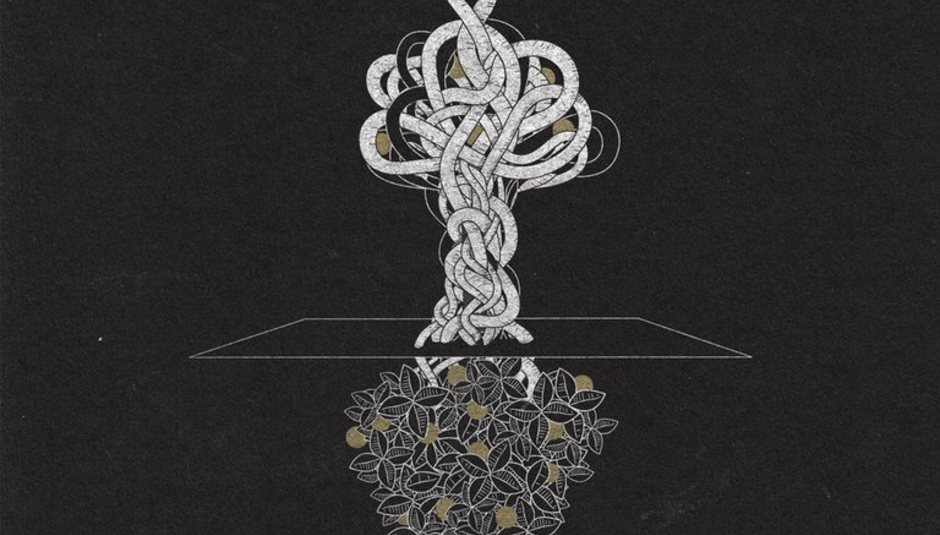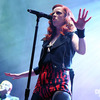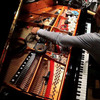For all the endless discussion about the future of music in the digital age, we’ve so far seen very little in terms of innovation in musical form. So, the CD is dying, the MTV era is over and even the sacred full-length record is becoming less relevant as our attention spans are increasingly pummeled by distractions, but what does the future hold? Of course there’s no simple answer to that, but it’s surprising to me that more people haven’t deviated from standard release formats and challenged the way in which we engage with music.
One person who shares this view is Eric Wahlforss, co-founder of Soundcloud and the man behind electronic music moniker Forss. We’re in a Berlin cafe the morning after the launch of his new project – Ecclesia – which takes form partly as an album, but also as a fully functional iPad app, installation and art-piece. Despite the project’s futuristic leanings, though, its inspiration is rather older, in fact, a lot older. Relying heavily on samples from choirs, organs, bells and so on, Ecclessia attempts to recreate the essence of what a church is, and re-contextualise it for our generation.
The previous night Wahlforss launched this project in the world-famous Berghain club; another impressive, high-ceilinged, glass windowed space which makes for the perfect host. The instillation element of the record takes shape as a 10ft frame which hangs above the crowd, displaying the religious-themed visuals from the app which are controlled from iPads. Wahlforss is joined on stage by digital artists Leo Lass and Marcel Schobel, who worked with him on developing the app and also join me today to discuss the project. After quizzing me on my method of recording the interview (“Soundcloud has a record function don’t you know?” Never shying away from a plug), we discuss the project and explore a world of untapped audio-visual possibility.
What kind of space do you see for Ecclesia? Obviously you can’t bring it to the Berghain every time, so where do you see it? Would you consider bringing it full circle and back into the church, for example?
Eric Wahlforss: That’s a good question. We actually set out building an app and an instillation piece. Actually, we tried to come up with a way not to perform it live – as in, perform the music ourselves. I’d tried performing electronic music live for like three years, which was a while ago now, but I realised after those three years that it’s kind of not my form, and I don’t want to play live. So with this album, we came up with the idea of having the app as a kind of instillation in your pocket, so you can take that same medium and blow it up big. Because of the restraints that the Berghain people had put on us to be able to perform there, they wanted us to be on stage and so on, so we put together this minimal live show for this one night. But really, I think the idea would be to have it in a smaller room but with this giant frame, like a church window sort of thing, and an interface with some good speakers. A few people could come in at a time and navigate through that...that was one idea we had to bring it into a live environment. And with regards to doing it in a church, I think the paradox is that this music probably wouldn’t work so well in a church because there’s so much reverberation, and the acoustics in the church is actually kinda terrible for electronic music, unless you’re doing like ambient stuff. But if you want to have these precise beats and stuff it doesn’t really work so well.
Leo Lass: I think also it would be too much to bring it back to a church because the church is already in the samples, the sound and the visuals as well. We also like this changing of the context –the church has no meaning for our generation anymore, so we bring it to a space that does have meaning for us, like the Berghain, which is an impressive space and is like a church in itself for techno. I think it’s the clash of those two worlds which make it interesting.
Eric Wahlforss: The church in your pocket! Haha.
And when you first conceived of the idea, did you always have this visual app idea in your head, or were you already making the music and that idea developed later?
Eric Wahlforss: I think that nine years ago when I made my first album, I already had some quite strong ideas about doing something more than just the music. I was looking at and remembering the ninja tune stuff from back in 98 and some quite cool stuff already happening from that scene.
Marcel Schobel: Yeah, like the CD-ROM stuff and Hexstatic and all that kind of thing.
Eric Wahlforss: Exactly, the CD-ROM stuff, it goes back a long way when you think about it. I think in 2003 I didn’t have enough resources, I was quite young and just happy enough to bring out the CD really. iTunes had just launched in 2003 so eventually I had it as a digital version as well, but I felt like, ‘ah, I want to do this one more time and do it well.’ So the whole audiovisual side of things has been with me a long time now. I think it was with the launch of the iPad that I suddenly felt, ‘oh, now this is the time’, because it was just a new medium basically with which to do things like that.
Do you think, given the technology available, we’re going to see artists playing around with the visual aspect of music on a wider scale? It seems to me that music being released in this conventional way is incredibly static, given the wealth of possibilities...
Leo Lass: I think definitely, because with the death of the CD, and basically all the artwork, sooner or later there will be a need for something new, a new hour, a building around the music to get the image or story across. I think the iPad will be one of those channels used, but it’s sure not the only one, it’s very specific still. But what the iPad brought is a more intimate computer device. We were talking about CD-ROMs and with those you had these huge computers that were in a desktop, working environment. The iPad is something that you can take to bed even, it’s very cosy and not a ‘working device’.
Marcel Schobel: It’s super exciting if you’re thinking about the technology, especially when Bjork announced her iPad release and people were talking about ‘will this be the future of music releases?’ and this and that, but if you do a little research you’ll see that musicians have always strived for these kinds of special formats. Like big fold-out record covers, or there was a Cheech and Chong record that huge rolled out joints with it. This stuff has always been around and now we have the iPad, and other devices, and there’s always been a knack for artists to express themselves visually. The music video has been a history of success for the past 30 years, but there’s now a demise in music videos because there’s no more MTV and music videos were interesting in that era of the 80s and 90s. There hasn’t ever been a way to make a coherent thing, like visuals and sound and everything in one format – and that’s what we tried to do with the iPad. Will consumers appreciate it? I don’t know, time will tell, if it’s done right...maybe.
Eric Wahlforss: It feels so great for us as sort of ‘media artists’ to finally have this format where it’s just a very clean device, very well executed, distribution is solved, graphics are amazing and interaction too.
Leo Lass: It’s really intuitive, intimate, magical...it’s amazing to finally have that.
Marcel Schobel: And that is definitely new, because the thing with CD-ROMS is you had to install it, sit in front of the computer and it would crash – all these things, it was not a very intimate experience that you would have.
As you mentioned with those traditional artwork concepts, it’s one thing to have something visual to look at and even hold, but something completely different to actually be able to interact and put yourself into it. With something like Soundcloud we’re able to see how music breathes and moves, but this almost seems like a more detailed extension of that..
Eric Wahlforss: Well obviously seeing as I work on Soundcloud as well, we were thinking about the boundaries – like, shall we bring Soundcloud into this experience as well? But I think Soundcloud as a medium is quite established as social media, so y’know it’s Facebook, it’s Twitter, it’s YouTube, and these services are part of a hyper media mash-up with lots of stuff coming through and that’s part of what the internet is today.
But with this project it’s like it’s again its own format, it’s something completely different. The iPad is a solo experience that is relatively conservative, compared to something like Soundcloud which is actually relatively interactive. But if you want to bring out music in a coherent way, while Soundcloud could power the sound, the experience as an artist might not be quite what you want in terms of the final output. Soundcloud is great for distribution, it’s great for viral growth and the spread and integration of music, but as a sort of reference format this is much better.
Yeah I see what you mean, so what experience were you looking to give users of the app?
Eric Wahlforss: There were a lot of things that we considered doing that we ended up not doing, because we feel like a lot of what’s already out there is gimmicky. It’s like social media for the sake of being social media. We tried to really boil it down to what adds to the integrity of the art piece, and what makes it more powerful instead of less powerful. Also, we’re not particularly fond of reactive music or interactive music, things like where you move the iPad things start sounding completely different, or where you can remix or re-edit tracks. All of these possibilities were available to us, but we tried to consider what we actually want and what we ended up with was quite conservative in that sense.
Marcel Schobel: Yeah, we’ve actually discussed this between ourselves many times that it is quite a conservative approach. Because it could become super interactive with every element, and I actually mentioned it a couple of times, ‘shouldn’t we do things a little more interactively?’ But I am glad that we didn’t, because now I think it’s the piece that it was by itself, the music is dictating the visuals not the user – it’s a contemplative experience that you have and I hope people connect deeper with the music while looking at the images, not to like play around with it and have a gaming experience. I’m not a big fan, I have to say, of the Bjork approach for example, because I just couldn’t figure out what to do with it. It’s not a game, it’s also not real good audio-visual music, and so what is it? We wanted to have good visuals, good music, and hopefully create an emotional bond between the app and the audience.
Eric Wahlforss: I think contemplative is a great word, that’s really the highest state we could hope for. It’s not a book, it’s not a pure album, it’s a new medium that’s something in between and adds to the experience.
And how about the actual images themselves? There are a lot of quite strong biblical references at play, so is there also a particular story at the app’s heart?
Leo Lass: Yeah, actually when we first got the tracks we decided to create a visual reference system as well. So we were hugely inspired by the track titles to begin with, and we built our own story and had our own linear dramaturgy, starting with the intro with the bells and the very traditional image of opening and welcoming. Then we had another reference system underneath that, and based on those we he have these illustrations – they weren’t in the live show, just in the app – but there’s one illustration for each song that references all the stories behind the tracks. It’s a kind of surreal, enigmatic, it’s a bit mystical; you can’t really get the whole idea, but there are a lot of points to dig into which set the stage more or less.
Marcel Schobel: Hopefully those symbols resonate within you and trigger something. Like Leo said, it’s enigmatic, we don’t point into one specific direction. I actually looked into a lot of books about churches and symbols, and we realised we can’t use them so opaquely, we have to fragment them...a bit like the music in the way in that it’s all fragments of samples put together in their own way. So we have all these referential systems constructed in our own meta-story and hopefully it resonates within you and triggers something, maybe not, it’s like with abstract art, maybe that triggers something or maybe it doesn’t.
It’s my understanding that none of you are actually religious, so what sparked the interest in this particular project to begin with?
Leo Lass: No, that’s right. It’s more like our cultural backgrounds which are very influenced by the Catholic Church. We are not fond of religion.
Eric Wahlforss: I feel like almost, in a sense, I haven’t had time to be religious in my life – I’m always rushing haha! My mother conducts a choir and plays the organ, so I’ve been in the church quite a lot but it’s always been through music, it’s never really been for religious reasons. My mother has a similar relationship, she’s not really religious, but she loves the spiritual music part of it.
Outside of the more traditional elements of the record then, where do you draw influence from in electronic music?
Eric Wahlforss: It’s interesting sort of reflecting back on 15 years of electronic music. For me, there aren’t that many moments where I’ve felt really inspired, or where something really takes everything up a notch and changes the game. One of my first reactions with electronic music was DJ Shadow’s Endtroducing in ‘96, and shortly after that the Photek album Modus Operandi. Before that I had other interactions with electronic music, but I hadn’t heard this kind of heavily sample based form. So that’s when it started, and after that there have only really been a few occasions where I’ve been really inspired.
It’s also interesting that a lot of people think of DJ Shadow as being really soulless, a lot of hip hop producers don’t really like it because it’s too perfectionist. It’s really white music in a sense. I think my music sounds the same in that way, it’s hard for me to reflect on, but it’s a little bit soulless and precise – and there’s something that emerges out of that which I really like. I like electronic music which is like a polished diamond, which you try and perfect into its coherent shape.
I only ask because so much of electronic music has such obvious reference points, whether it falls under house or techno, or even a hybrid of sorts. But with Ecclesia it was quite difficult for me to place it in terms of influence...
Eric Wahlforss: Right, yeah. I mean I’ve listened to a lot of house and techno, and I have a lot of favourite house and techno tracks. I like a lot of electronic music, but I’m more inspired by club music that isn’t really club music, that’s really the music that I regard the highest. Not necessarily dance music, but listening music.
How did you find this challenge of uniting modern and traditional sounds together? Were you looking for a seamless blurring of the two or for a more jarring relationship?
Eric Wahlforss: There were two really interesting challenges in that. One was that the instrumentation is very challenging for electronic music. To have a church organ which is really all over the place in terms of the harmonics and the sound spectrum, and the same goes for choirs which are sort of these giant textures which are quite difficult to tame without it turning it into a sort of wishy-washy ambient music. So that was a big challenge, from a production point of view, to make it sound really tight and precise with these kinds of instruments, and it took lots of tries and tests to get it right.
The other challenge I think is bringing together this ancient stuff and this really modern sound and getting it to work together. For me as a producer I think that’s why I did the music in the first place, because it’s such a tough challenge. It really is quite a grand challenge trying to make all these elements work.
Marcel Schobel: Now it’s out, so we’ll see if it all came together!
Ecclesia is out this week.























